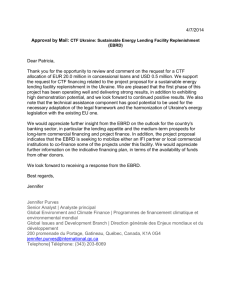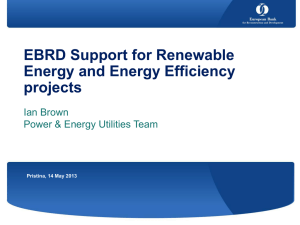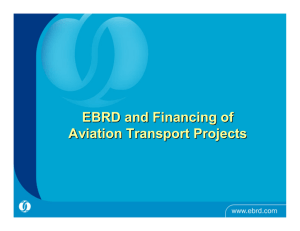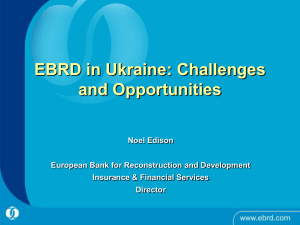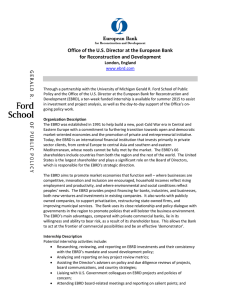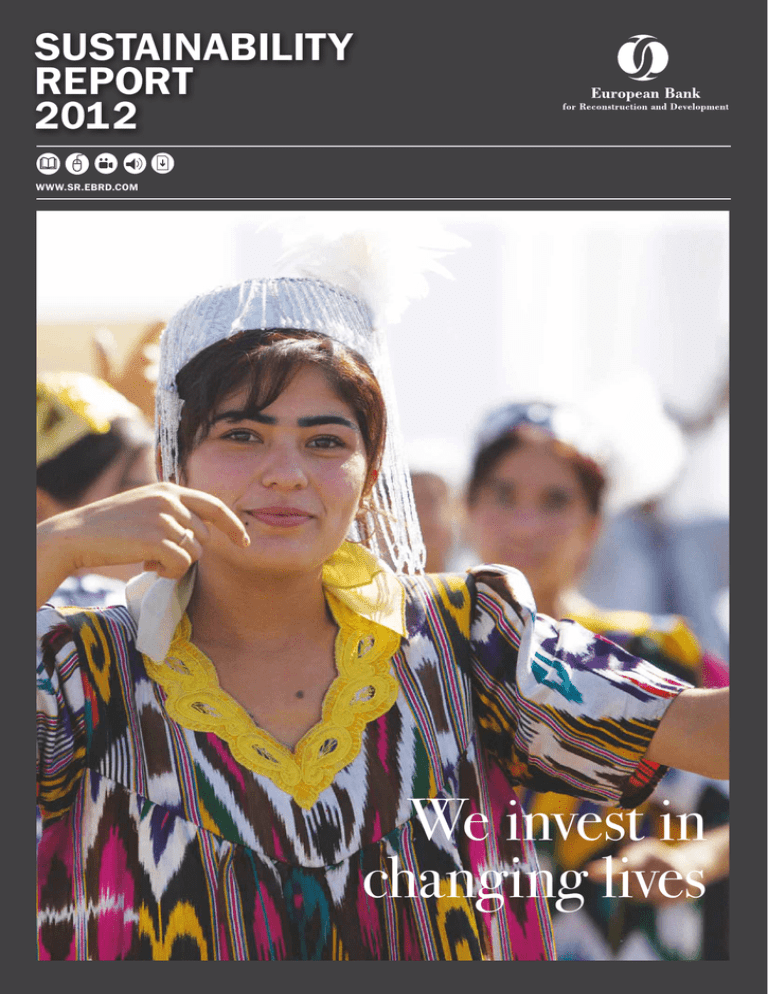
sustainability
REPORT
2012
www.sr.ebrd.com
We invest in
changing lives
This document is a summary of the EBRD’s Sustainability Report 2012.
The full report can be found on our website at www.sr.ebrd.com
The Bank’s 2012 Sustainability Report
This Sustainability Report has been prepared using the framework of
the Global Reporting Initiative (GRI) G3 Indicator protocols and the GRI
Financial Sector Supplement. The Bank has self-declared a “B” rating
according to the GRI application levels shown at www.ebrd.com/gri.
The GRI Content Index is also published at the same address.
Front cover: Tajik woman participating in a local festival, Tajikstan.
Suma Chakrabarti
EBRD President
Introduction
Environmentally sound and sustainable
development is central to the EBRD’s
activities. This Report looks at three vital
elements of the Bank’s contribution to
sustainability – Assurance, Impact
and Engagement.
All EBRD-financed projects must meet rigorous environmental
and social standards in accordance with the Bank’s Environmental
and Social Policy and are subject to detailed due diligence
and monitoring. In this way the EBRD provides Assurance
to its shareholders, management, and other stakeholders that
the Bank’s projects will contribute to sustainable development
and avoid or minimise environmental and social risks.
The Bank aims to achieve Impact by integrating sustainability into
its investment strategies, departmental scorecards, due diligence
standards, portfolio supervision systems and technical assistance.
This forms an important part of the value that it brings to its clients
and countries of operations, as well as delivering a high level of
environmental and social quality assurance.
The Bank places a strong emphasis on Engagement with
stakeholders and is an active participant in international
sustainability initiatives and policy development. The EBRD
also operates a robust independent complaints mechanism.
In this way, the EBRD seeks outcomes that not only protect and
benefit society and the environment, but which also promote
transition to market oriented economies and more democratic,
pluralistic societies. Helping clients to manage environmental and
social risk, improve energy efficiency, increase female participation in
the workforce or involving community groups in project development
are fully aligned with the EBRD’s central mandate and purpose.
Suma Chakrabarti
EBRD President
EBRD SUSTAINABILITY REPORT 2012 1
2 EBRD SUSTAINABILITY REPORT 2012
WHAT WE DO
CHANGES LIVES
The EBRD is investing in changing
people’s lives from central Europe
to central Asia and the southern and
eastern Mediterranean. Working primarily
with the private sector, we invest in
projects, engage in policy dialogue and
provide technical advice that fosters
innovation and builds sustainable and
open market economies.
EBRD SUSTAINABILITY REPORT 2012 3
Assurance
The Bank’s policies, procedures and management
systems for environmental and social issues
continued to deliver a high standard of assurance
in 2012 through robust due diligence of new projects
and effective monitoring of portfolio quality.
The Bank’s policies and procedures
The Bank’s Environmental and Social Policy requires that all projects are assessed,
structured and monitored to ensure that they are environmentally and socially
sustainable, respect the rights of affected workers and communities, and are
designed and operated in compliance with applicable regulatory requirements and
international good practice. This Policy works in conjunction with other Bank policies
– particularly the Public Information Policy and the Project Complaint Mechanism –
to provide a high level of assurance, transparency and accountability.
The Bank’s Environmental and Social Policy – last updated in 2008 – will be the
subject of a periodic review in 2013. Other important policies that are also scheduled
for review in 2013 include the Public Information Policy and the Project Complaint
Mechanism. Stakeholder consultation will form an important part of these reviews.
4 EBRD SUSTAINABILITY REPORT 2012
Operational results in 2012
Environmental and
Social Category
Category A
Category B
Category C
Category FI
€m
1,261.9
3,849.3
1,261.9
2,209.3
% by
volume
17.1
52.2
17.1
30.0
No. of
% by no.
projects of projects
18
6.2
136
46.7
18
6.2
132
45.4
The environmental and social category – A, B, C or FI (Financial Institution) – reflects
the potential impacts associated with a proposed project and determines the nature
of the environmental and social appraisal, information disclosure and stakeholder
engagement required.
Environmental and social monitoring
of the portfolio in 2012
Clients are required to report to the EBRD at least once
a year on their environmental and social performance and the
implementation of their Environmental and Social Action Plan
(ESAP). Across the portfolio, 95.2 per cent of projects have
fulfilled this environmental and social reporting requirement
within the last two years.
At the start of 2012, the EBRD’s portfolio included 50 Category
A projects. Based on monitoring and supervision during the
year, 86 per cent of these projects were considered by the Bank
to meet or exceed our environmental and social requirements.
We provide enhanced supervision and assistance for projects
that currently do not fully meet the Bank’s requirements.
EBRD SUSTAINABILITY REPORT 2012 5
SLOVAK REPUBLIC: CONSTRUCTING THE RI EXPRESSWAY
R1 Expressway,
Slovak Republic
The R1 motorway in the Slovak Republic is an important
transport link and a key section of the European road corridor
E58. The project includes construction of a total of 52 km of
highway. The total cost of the project is approximately €1.3
billion, of which the EBRD is providing €200 million via a loan to
Granvia, which holds the 30-year concession to build, finance,
operate and maintain four sections of the R1.
Effective monitoring and supervision by the EBRD since
approval in 2009 confirms that the project meets applicable
environmental and social standards and Granvia’s commitment
to good practice.
6 EBRD SUSTAINABILITY REPORT 2012
Granvia’s commitment to EHS and community awareness included
interactive training ‘Alive on Site’ for all R1 on-site workers; measures
to protect birds agreed with the local nature conservation authority;
and routine stakeholder engagement activities with the public and
relevant authorities. Granvia has a grievance mechanism in place
and the Bank’s monitoring confirms that problem-solving initiatives
following complaints were effective. A transport management plan
was developed for the project to cover a range of risks both on-and
off-site, including effective control measures to reduce the risk
of traffic incidents such as radar speed signs located on local
community roads used by R1 construction traffic to access
work fronts.
The EBRD’s experience with projects such as R1 underlines the
importance and value of open discussion and frequent reporting
on EHS issues, enabling all parties to understand the constraints
of the work programme and to anticipate and respond to challenges
on site.
In June 2012,
the EBRD committed
to a loan of up to
€200 million to
fund a key section
of an important
new toll road that
will bypass the
historic centre of
St. Petersburg
RUSSIA: DEVELOPING THE WESTERN HIGH SPEED DIAMETER
The Western High Speed Diameter project,
St. Petersburg
In June 2012, the EBRD committed to a loan of up to €200 million
to fund a key section of an important new toll road that will bypass
the historic centre of St. Petersburg. It joined four other banks
in raising a total of nearly 59 billion roubles (equivalent to €1.5
billion) for a project which could divert up to 140,000 vehicles
a day from this World Heritage site.
The WHSD is a by-pass motorway, designed to relieve pressure
from the road network and improve passenger and cargo
flow by connecting the city’s major commercial port with the
St. Petersburg Ring Road in the south and with the Scandinavia
motorway to Finland in the north. The motorway will have a total
length of 46.6 km, with four to eight lanes (depending on the
section), 14 traffic interchanges and with estimated daily traffic
of over 100,000 vehicles.
The Environmental and Social Impact Assessment (ESIA) for
the project was prepared to international standards. It focused
on the impact of the construction of the central section, as well
as reviewing the environmental and social impacts of constructing
the southern and northern sections of the motorway. The ESIA
demonstrated that the potential impacts on residential areas,
such as noise and air quality, could be effectively mitigated by
noise screens and improved road layout. The road is planned to be
built in an open trench/tunnel through much of Vasilievsky Island,
which will prevent visual blight and reduce significant noise and
atmospheric pollution.
EBRD SUSTAINABILITY REPORT 2012 7
Impact
The EBRD invested €8.9 billion in
new projects in 2012, helping clients
achieve a wide range of positive
environmental and social outcomes,
from the introduction of best practice
management systems or improved
energy efficiency, to social protection
for affected communities or increased
economic empowerment of women.
Energy and climate change
The EBRD addresses climate change and energy efficiency
through its Sustainable Energy Initiative (SEI). The SEI aims
to scale up sustainable energy investments, improve the
business environment for sustainable energy investments,
and develop effective measures to address key barriers to
market development. In 2012 the Bank’s SEI financing volume
reached €2.28 billion, with a total project value of €13.9 billion.
In a challenging environment, SEI investments accounted for
26 per cent of the Bank’s total annual business volume in 2012.
Sustainable energy was a feature in 35 per cent of new projects
signed by the Bank in 2012, with investments being made across
a broad range of sectors and countries.
The year 2012 was a milestone for SEI, as the financing volume
since its launch in 2006 reached €10 billion as at the end
of October. This corresponds to more than 550 projects and
a total project value of about €55 billion. The cumulative
emission reductions resulting from SEI investments since its
start in 2006 are estimated at about 50 million tonnes per year,
once all of the investments are implemented and operational.
Climate Adaptation
In 2012, the Bank continued to expand its adaptation projects
further. In doing so, the EBRD finances “hard” adaptation
measures (including physical modifications and additional
infrastructure/technology) and also supports “soft” adaptation
measures (such as adaptive management to provide improved
flood or hydrological monitoring and emergency response plans).
8 EBRD SUSTAINABILITY REPORT 2012
BOSNIA AND HERZEGOVINA: FINANCING ADAPTATION
IN THE PULP AND PAPER INDUSTRY
Financing Adaption IN THE PULP AND PAPER
INDUSTRY
In 2012 the EBRD financed the €11 million rehabilitation of
Natron Hayat, a pulp and paper factory located in Maglaj, in
central Bosnia and Herzegovina. This is a highly water-intensive
industry, in a region where surface run-off is projected to
decrease by 12.5 per cent by 2050 and by 19 per cent by 2100.
The preparation of this investment included an energy and water
use audit, which was funded through the EBRD-Western Balkans
Fund and aimed at identifying efficiency opportunities for both
energy and water that could be implemented in connection with
the company’s investment plan. This included a water availability
stress test using climate scenarios up to 2050.
The investment programme developed should result in water
savings of 6.3 million m3 per year, to be achieved through water
recycling and loss reduction.
MOROCCO: ENHANCING ENERGY EFFICIENCY
FOR AN OIL PRODUCER
Improving Energy Efficiency AT
MOROCCO’S LEADING EDIBLE OIL PRODUCER
The EBRD is financing the construction of a €2.5 million
biomass boiler for Lesieur Cristal, the leading edible oil
producer in Morocco. The biomass boiler will contribute
positively to the company’s goals of energy cost optimisation
and sustainability, thereby improving the energy efficiency
and overall profitability of its operations and will avoid annual
emissions of 12,700 tonnes of CO2. In addition, the EBRD will
deliver an energy and water efficiency audit for Lesieur Cristal
within the framework of the Bank’s regional Energy
Audits Programme to help identify other areas of
potential improvements.
RUSSIA: CUTTING CO2 EMISSIONS FROM GAS FLARING
Cutting CO2 emissions from gas flaring
Huge volumes of associated petroleum gas (APG) are currently
flared or vented from oil fields worldwide. Globally, APG flaring
wastes some 140 billion cubic meters of gas per year, roughly
equivalent to a third of the annual gas consumption in the
European Union or 75 per cent of Russia’s gas exports.
It also contributes to more than 400 million tonnes/year
of CO2 emissions.
The EBRD has financed two important gas flaring reduction
projects in Russia (Monolit US$ 55 million and Irkutsk Oil
US$ 115 million). Both projects share a similar approach
in the technical and commercial arrangements. Monolit, for
instance, is an excellent example of how an integrated approach
can be employed to address the environmental problems of gas
flaring and deliver several valuable products. At Monolit, the APG
is treated with innovative technology for gas processing and
gas-to-liquid conversion. Dry gas is delivered through a newlybuilt 70 km-long gas pipeline. Gasoline and LPG are delivered
with new road tankers, and electricity is used on site and sold
to other nearby oil operations, thus minimising the need for
grid infrastructure. Irkutsk Oil is developing a similar concept
in phases, whereby the residual APG is also re-injected into
the oil fields.
Global Forum on Flaring Reduction
and Gas Utilization
Representatives of the EBRD, the World Bank and other GGFR
partners met in London in October 2012 and announced plans
to increase efforts to reduce the flaring of natural gas associated
with oil production. The Forum, hosted by the EBRD, brought
together representatives from governments, industry, technology
developers, and other international organisations, and marks the
10th anniversary of the public-private partnership, launched at
the 2002 Summit for Sustainable Development in Johannesburg.
Greenhouse gas assessment 2012
The GHG Assessment methodology is applied only to projects
that have been identified as having a significant GHG impact (either
positive or negative).
Out of 380 commitments signed by the Bank in 2012, 31 projects
met the criteria for inclusion in the GHG Assessment. The remaining
projects were reviewed and estimated to be below the Bank’s
screening threshold of 20kT C02e per year. The EBRD estimates
that the projects above this threshold contribute 80-90 per cent
of total GHG emissions or savings.
The overall impact of these 31 projects is expected to be a net
change in GHG emissions of approximately 2.0 million tonnes
of CO2 per year.
This is an ex-ante estimate of carbon savings that will be
achieved in the future once the projects have been implemented.
The actual carbon savings that are realised in practice may
be higher or lower than the estimates calculated under the
GHG Assessment methodology.
This is the tenth year that the EBRD has published GHG forecasts
and the seventh consecutive year that the overall impact of our
investments has been a net GHG saving.
GREENHOUSE GAS ASSESSMENT
RESULTS 2006-2012
Aggregate Change in CO2e (M TONNES)
-8.0
-6.1
-5.0
-4.5
-2.0
-0.3
-0.2
2006
2007
2008
2009
2010
2011
2012
EBRD SUSTAINABILITY REPORT 2012 9
Water and waste management
Investments in water and wastewater are important elements
of the Bank’s operations in the municipal and environmental
infrastructure (MEI), sector, which accounted for €228 million
of the Bank’s new business in 2012.
Throughout 2012, the EBRD continued to develop innovative
projects, deliver policy dialogue successes and expand support
for small and medium-sized municipalities, with a strong focus on
those countries with the greatest need, particularly in Central Asia,
the Western Balkans, Russia and SEMED. The Bank’s financing
mobilises significant additional investment, particularly from the
EU Cohesion Funds.
The Bank updated its MEI Strategy in 2012. The new strategy
underlines the EBRD’s commitment to deliver tangible benefits
to communities across the region, including increased emphasis
on integrating policy dialogue alongside investment; more robust
measuring of progress achieved towards sustainability; a greater
focus on climate resilience; and the mainstreaming of gender and
inclusion considerations in project design.
ARMENIA: PROTECTING THE WATERS OF LAKE SEVAN
Armenia: protecting Lake Sevan’s waters
The EBRD is helping people living around Lake Sevan, Armenia’s
major water basin, to preserve their environment and health with
a much needed upgrade of wastewater services.
Since the Soviet era, profligate use of the lake’s water for irrigation
and electricity generation had caused the level of the lake to drop
by 20 metres, with dramatic consequences for the natural
environment. Today, thanks to a rescue plan, the water level is
rising again, giving hope that the lake can regain its original shape.
To help the Armenian government bear the high costs of a
wastewater system upgrade in five municipalities around the lake,
the EBRD has provided a €7 million loan and the European Union
has contributed a €5 million capital expenditure grant. The project
includes sewer pipe repairs in the Sevan and Jermuk area and
construction of sewer networks and wastewater treatment plants
to serve the towns of Gavar, Vardenis and Martuni.
the EBRD has provided a €7 million
loan and the European Union has
contributed a €5 million capital
expenditure grant.
10 EBRD SUSTAINABILITY REPORT 2012
MAKING ROADS SAFE ACROSS THE REGION
Road safety in the EBRD’s region is a major problem, with some
50,000 annual fatalities and 500,000 casualties. The socioeconomic cost of road accidents is also a very real factor for the
victims and their families.
The EBRD is trying to improve road safety investments in road
infrastructure that meet best practice standards. Road safety
considerations are an important and integral component of the
project preparation and due diligence process for all Bankfinanced transport projects. In addition, the Bank operates road
safety technical cooperation programmes which can deliver
targeted support – such as training – where it is needed.
HOSTING THE COMMISSION FOR GLOBAL ROAD SAFETY
Commission for Global Road Safety
In 2012, the Bank hosted the Annual Meeting of the Commission
for Global Road Safety. The aim of the Commission is to make
road safety issues a priority for governments and international
organisations.
The Bank signed an MoU with the International Road
Assessment Programme (iRAP) at the Annual Meeting,
underscoring its commitment to invest in road projects that
meet recognised safety standards. Plans were outlined to
engage further with private sector clients to develop public
awareness and road safety campaigns.
As one example, the EBRD Republic of Serbia Rehabilitation
and Safety Project (to be signed in 2013) will finance the
rehabilitation of 2,500 km of roads, with explicit road safety
targets, and plans to identify a private sector partner to fund
a targeted road safety awareness campaign.
EBRD SUSTAINABILITY REPORT 2012 11
Gender: PROMOTING GENDER EQUALITY
AND EMPOWERMENT
The EBRD’s work on promoting gender equality is a good
example of how social sustainability can align with the transition
to open, market-oriented economies. Increasing economic
opportunities for women will not only improve the lives of those
who benefit directly from those opportunities, but will also
increase availability of labour and enhance the skills base in
transition economies.
The EBRD launched a Gender Action Plan (GAP) in 2009 to:
“promote equality of opportunity and women’s empowerment
through its projects and seek to prevent gender discrimination
and mitigate inequalities”.
The EBRD is now developing its first Gender Strategy, building
on the lessons learned over the last three years and intended
to significantly increase this aspect of the Bank’s transition
impact. The main purpose of the strategy is to assess existing
gender gaps both in countries of operations and the potential
recipient countries of EBRD operations in SEMED, and identify
how the Bank can help to address these gaps through its
projects, technical assistance and policy dialogue. The Gender
Strategy is expected to focus on three key themes: access to
employment, access to finance, and access to services and
will be agreed in the first half of 2013.
EBRD promotes
equality of
opportunity and
women’s
empowerment
through its
projects
TURKEY: ENCOURAGING WOMEN’S ENTREPRENEURSHIP
The Yapi Kredi Bank (YKB) SME Asset-Guaranteed Bond (approved
in 2012) is one of the first and most recent examples of successful
efforts to promote women entrepreneurship in Turkey. The Bank’s
investment will be used to expand YKB’s SME lending operations
to finance (1) SMEs operating in agribusiness in the priority regions
and, (2) SMEs which are managed or owned by women. The EBRD
will help YKB to establish a sub-SME segment, reaching the
underserved women-managed and owned SMEs and effectively
“mainstreaming” gender into the Bank’s operations. The Women
in Business (WiB) initiative that the Bank has proposed will
enhance YKB’s internal capacity to identify women-owned and
managed businesses specifically in the agribusiness sector as
well as in more general SMEs and increase their share in YKB’s
loan portfolio. This will be achieved through enhancement of the IT
system, data analysis, business advisory services and support in
developing dedicated products and/or more general products/
approaches that would overcome some of the barriers faced by
women entrepreneurs in accessing credit.
SERBIA: PROMOTING SOCIAL PROTECTION
A recycling centre that earned Serbia’s capital Belgrade a top
award from the Council of Europe for promoting social protection
for Roma people was brought into the limelight by the visit of a
high-profile international delegation, headed by the UN’s Secretary
General Ban Ki-Moon.
The EBRD has played a key role in placing the issue of Roma
people high up on the city’s agenda, when it agreed to finance
the roads surrounding Belgrade’s Gazela Bridge, alongside the
European Investment Bank, which financed the reconstruction
of the crumbling bridge. The project included an important social
component aimed at resettling and restoring the livelihoods of
175 Roma families that used to live under the bridge.
In addition to offering temporary alternative accommodation to
Roma families, the international community and Belgrade
authorities worked together to provide them with personal
identification documents that many Roma people did not possess.
This ensured that their basic civil rights were protected and that
they had access to social services, such as education and health
care. Over 90 per cent of the children are now attending school
in Belgrade.
12 EBRD SUSTAINABILITY REPORT 2012
Sustainability in SEMED
The southern and eastern Mediterranean (SEMED) is the latest
region in which the Bank is working to boost economic and
democratic change. Egypt, Jordan, Morocco and Tunisia have all
asked to become EBRD countries of operations, requests which
will require the Bank’s founding articles to be ratified accordingly.
The EBRD’s shareholders approved the creation of a €1 billion
special fund to launch investments in the four countries at its
Annual Meeting in London in May 2012. The first investments in
Jordan, Tunisia and Morocco were given the go-ahead in
September 2012. Eventually, the EBRD expects to be able to invest
up to €2.5 billion a year in the region.
Environmental and social sustainability issues were an integral
part of the Transition to Transition Initiative during 2012, a
framework within which the EBRD is facilitating and developing a
peer-to-peer exchange of transition and reform experience
between the Bank’s current countries of operations and countries
of the SEMED region. Events have so far taken place in Egypt and
Tunisia, with events in Morocco and Jordan to come, involving
in-depth discussion on key sustainability issues such as food
security, water scarcity, climate adaptation, sustainable energy
financing, gender and inclusion.
Environmental Sustainability Bonds
Nuclear safety
The EBRD funds its lending operations primarily through the
issuance of bonds on the international capital market. The
Bank’s debt instruments take the form of Eurobonds, global
bonds and domestic issues in selected markets. In 2012, the
Bank’s total issuance under the borrowing programme amounted
to €6.3 billion.
The EBRD plays a prominent role in promoting nuclear safety in
central and eastern Europe, working in close collaboration with
donor governments and other international agencies. The EBRD
manages six donor funds providing support to enhance nuclear
safety. Some 30 donors, including the G8 countries and
the European Commission, have pledged more than €3 billion
so far to funds that include:
The Bank issued two new “Environmental Sustainability Bonds”
in 2012, targeted at Japanese retail investors. The bonds are
denominated in Indonesian Rupiah (IDR 61 billion each), pay
a fixed rate of interest monthly and mature in 2016. In total,
the EBRD has now issued eight green bonds for an equivalent
of €125 million.
• the Nuclear Safety Account (NSA)
• the Chernobyl Shelter Fund (CSF)
• three international decommissioning support funds for
Bulgaria, Lithuania and the Slovak Republic
• the “Nuclear Window” of the Northern Dimension
Environmental Partnership Support Fund (NDEP).
UKRAINE: ENSURING SAFETY AT CHERNOBYL
A major step towards ensuring the long-term safety at Chernobyl
Nuclear Power Plant has been achieved with the successful
completion of the first lifting stage of the New Safe Confinement.
When fully assembled the New Safe Confinement structure will
have a span of 257 metres, a length of 164 metres, a height of
110 metres and a weight of 29,000 tonnes. It will then be slid
over the Object Shelter covering the destroyed Unit 4 of the
Chernobyl Nuclear Power Plant. During the initial lifting operation
around 5,000 tonnes of steel was raised to a preliminary height
of up to 22 metres. The successful implementation of the New
Safe Confinement will both significantly reduce the risk of further
radiological contamination, and provide equipment and facilities
to address the challenges of long term deconstruction of the
Object Shelter and its inventory.
The New Safe Confinement contract is funded through
contributions by over 40 donor nations to the EBRD Chernobyl
Shelter Fund. The Fund is expected to disburse around
€1.54 billion in support of the Shelter Implementation Plan.
It is expected that the New Safe Confinement, which will cost
about two-thirds of this amount, will be completed in 2015.
EBRD SUSTAINABILITY REPORT 2012 13
ENGAGEMENT
The Bank held dialogue with over
400 civil society organisations in
2012 and played an active role in
environmental and social policy and
international cooperation, both in
its countries of operations and at
the global level. Open and transparent
engagement with civil society, local
communities and other stakeholders
is an important aspect of the
EBRD’s mandate to promote the
transition to democratic, pluralist
and market-oriented economies.
Engaging with civil society
As part of our commitment to democracy and good governance,
we believe that open and inclusive dialogue with a wide range of
external stakeholders is fundamental to achieving sustainable
development. The EBRD’s engagement with civil society in 2012
broadly covered the impact of the Bank’s operations in countries
from central and eastern Europe to central Asia and the southern
and eastern Mediterranean (SEMED).
In 2012 over 1,900 civil society organisations (CSOs) were
registered with the EBRD and over 400 CSOs participated in
thematic meetings with the Bank’s staff.
The 2012 Civil Society Programme held at the London Annual
Meeting (17-19 May) saw the participation of around 60 civil
society representatives from the Bank’s countries of operations
as well as the SEMED region. The main focus included the
expansion into the SEMED region, political aspects of the EBRD
mandate, energy sector investments and the EBRD’s first Mining
Operations Policy.
International cooperation and policy
and dialogue
The EBRD maintains regular dialogue with other multilateral
development banks (MDBs), UN agencies and international
organisations on a range of key issues, including environmental
and social matters.
The Bank participated in several MDB working groups in 2012. Key
meetings and initiatives included cooperation on the development of
common MDB protocols for tracking finance in the climate mitigation
and climate adaptation spheres; improving the methodologies used
by MDBs for GHG assessment; and strengthening systems for the
evaluation of Climate Investment Funds. The EBRD is also actively
involved in work to strengthen the gender component of the Climate
Investment Funds, and currently chairs the MDB working group
on gender and employment.
14 EBRD SUSTAINABILITY REPORT 2012
SUPPORTING SUSTAINABLE DEVELOPMENT AT RIO+20
The United Nations Conference on Sustainable Development
– or Rio+20 – took place in Rio de Janeiro, Brazil on 20-22 June
2012 under the theme “The Future We Want”. Among the key
outcomes, member states decided to launch a process to
develop a set of Sustainable Development Goals, which will build
upon the Millennium Development Goals and converge with the
post-2015 development agenda, and also adopted important
new guidelines on green economy policies.
A joint statement from the EBRD and other MDBs highlighted
a number of priority topics for the core green growth agenda,
including climate change, ‘sustainable energy for all’, sustainable
cities, sustainable transport, food security and ‘water for all’.
www.ebrd.com/pages/news/features/ebrd-at-rio-plus-20.shtml
COLLABORATING WITH PARTNERS TO STRENGTHEN THE
CLIMATE INVESTMENT FUNDS
The EBRD is one of the five multilateral development banks
that work with the US$ 7.2 billion Climate Investment Funds (CIF)
to channel financing to developing countries for the mitigation
and management of the challenges of climate change.
In implementing CIF-financed projects, MDBs are collaborating
as never before with each other, governments, and other key
stakeholder groups. Leveraging the strengths of each group,
these partnerships are developing and demonstrating new
instruments, approaches, and practices for sustainable,
low carbon and climate resilient pathways that advance the
development objectives of governments and communities.
The EBRD’s role in the CIFs goes beyond the level of investment
projects, and the Bank has been actively involved in a number
of strategic and policy initiatives during 2012 in collaboration
with other CIF partners. In November 2012, for example,
the EBRD partnered with the Climate Investment Fund (CIF)
to co-host the 2012 Partnership Forum in Istanbul, and played
an active part in the Civil Society Observers Forum that preceded
the main meeting. The EBRD is also closely involved in policy
dialogue initiatives focusing on the gender dimension of the CIFs,
with the aim of improving the way the CIF projects are structured,
implemented and evaluated with regard to equality of
opportunities for both men and women.
The EBRD is
one of the five
multilateral
development
banks that
work with the
US$ 7.2 billion
Climate
Investment Funds
EBRD SUSTAINABILITY REPORT 2012 15
Sustainability
Awards
• The award for Excellence in
Sustainable Energy and Climate
Change – Denizbank, Turkey
• T he award for Excellence in
Environmental and Social
Performance went to the –
Irkutsk Oil Company, Russia
RECOGNISING EXCELLENCE AT THE EBRD’S
SUSTAINABILITY AWARDS
The EBRD’s Sustainability Awards took place during the Bank’s
Annual Meeting in London in May. The award for Excellence
in Sustainable Energy and Climate Change went to Turkey’s
DenizBank in recognition of its success in sustainable energy
financing and to acknowledge the leadership demonstrated by
DenizBank in becoming the first bank in Turkey to adopt the
Equator Principles. The award for Excellence in Environmental
and Social Performance went to the Irkutsk Oil Company,
Russia, recognised for going well beyond EBRD requirements
and taking a ‘best practice approach to a number of key issues,
including stakeholder dialogue, the management of associated
gas, and its success in generating and selling carbon credits.
16 EBRD SUSTAINABILITY REPORT 2012
EUROPEAN BANK FOR RECONSTRUCTION AND DEVELOPMENT
One Exchange Square
London EC2A 2JN
United Kingdom
SWITCHBOARD/CENTRAL CONTACT
Tel: +44 20 7338 6000
Fax: +44 20 7338 6100
INFORMATION REQUESTS
For information requests and general enquiries, please use the information request
form at www.ebrd.com/inforequest
PROJECT ENQUIRIES
Tel: +44 20 7338 7168
Fax: +44 20 7338 738
Email: projectenquiries@ebrd.com
EBRD PUBLICATIONS
Tel: +44 20 7338 7553
Fax: +44 20 7338 6102
WEB SITE
www.ebrd.com
EDITORIAL
Alistair Clark
Mark King
Martin McKee
Amanda Railson
Jane Ross
Dan Siddy
PHOTO EDITOR
Dermot Doorly
DESIGN AND PRODUCTION
luminous.co.uk
Daniel Kelly
PHOTOGRAPHY
Ib Katznelson – Cover
Andy Lane – p1, p4, p16
Lucia Sconosciuto – p1, p10
Dermot Doorly – p1, p5, p11, p12, p13, p14
Martin Zilka – p2, p6
WHSD – p7
Natron Hayat – p8
iStockphoto/Mikael Damkier – p8
iStockphoto/Sreako Petrovia – p9
John McConnico – p11
EBRD – p13
Monolit – p14
Martin McKee – p15
Printed in England by Fulmar which operates an environmental waste and paper
recycling programme. The Sustainability Report Summary 2012 is printed on Cocoon
offset. Fulmar is a carbon-neutral printer.
296 Sustainability Report Summary 2012 (E/1,000)
©
European Bank for Reconstruction and Development All rights reserved.
No part of this publication may be reproduced or transmitted in any form or by any
means including photocopying and recording, without the written permission of the
copyright holder. ~Such written permission must also be obtained before any part of
this publication is stored in a retrieval system of any nature.
Applications for such permission should be addressed to: permissions@ebrd.com
European Bank for Reconstruction and Development
One Exchange Square London EC2A 2JN United Kingdom
Tel: +44 20 7338 6000 Fax: +44 20 7338 6100
Requests for publications: pubsdesk@ebrd.com
www.sr.ebrd.com
European Bank for Reconstruction and Development
One Exchange Square London EC2A 2JN United Kingdom
Tel: +44 20 7338 6000 Fax: +44 20 7338 6100
Requests for publications: pubsdesk@ebrd.com
www.sr.ebrd.com
sustainability
REPORT
2012


